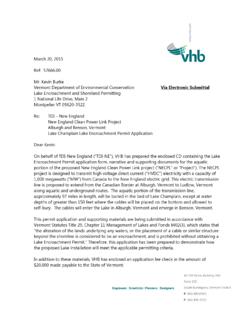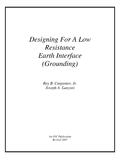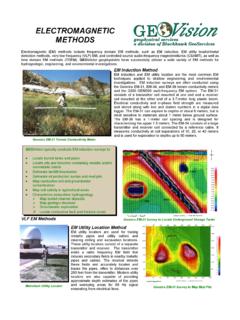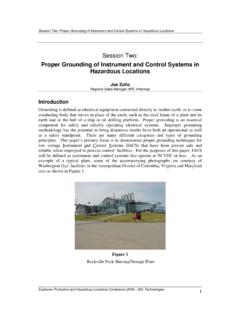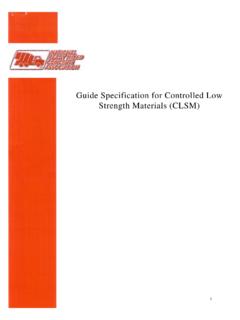Transcription of S e r v i c e s US Route 7 Post Office Box 120 …
1 Transportation Land Development Environmental Energy S e r v i c e s 7056 US Route 7 post Office Box 120 North Ferrisburgh, Vermont Memorandum To: NECPL Project File Date:December 2, 2014 Project No. From: Chelsea Martin, Environmental Scientist; and Adam R. Crary, PWS, PWD Re:Preliminary Wetland Impact Analysis At the request of Champlain, VT LLC d/b/a TDI New England ( TDI NE ) VHB has prepared this memorandum to summarize anticipated wetland permitting requirements for the proposed New England Clean Power Link ( NECPL or Project ), under Section 401 and 404 of the Clean Water Act ( CWA ) and the Vermont Wetland Rules ( VWR ), in connection with review of the NECPL under 30 Section 248(b)(5).
2 Section 248(b)(5) includes review of VWR significant wetlands under 10 Section 6086 (a)(1)(G), as well as other wetlands which are considered more broadly as part of the natural environment. This memorandum also serves to describe the preliminary impact analysis process used by VHB, as well as the avoidance and minimization efforts measures employed by TDI NE to minimize overall impacts to Class II and III wetlands and Class II buffers. The Project is described in some more detail in VHB s Section 248 Natural Resources Report ( NRR ) (Exhibit TDI JAN 2), but in general the terrestrial (or overland ) portion of the proposed NECPL transmission line involves the installation of a high voltage, direct current ( HVDC ) transmission line through portions of thirteen towns in Rutland and Windsor Counties and one town in Grand Isle County, Vermont.
3 Project authorization from the Department of the Army, Army Corps of Engineers ( USACE ) under CWA Section 404 is required for any unavoidable and cumulative impacts resulting from the discharge of dredged or fill material to Waters of the (which includes wetlands) that are subject to federal jurisdiction. As part of the Section 404 review process, a Water Quality Certification ( WQC ) under CWA Section 401 will be required from the Vermont Department of Environmental Conservation Watershed Management Division ( DEC WMD ). Due to the large area of the Project and the anticipated level of impact to jurisdictional waters of the state (including buffer zones) and , the Section 404, 401 WQC, and the Vermont Wetland Permit ( VWP ) will be in the Individual Permit review category.
4 The TDI NE/New England Clean Power Link Preliminary Wetland Impact Analysis Ref: Page 2 of 6 December 2, 2014 Project will also be required to obtain federal authorization under Section 10 of the Rivers and Harbors Act for activities associated with federal navigable waters, which are limited to Lake Champlain. PROJECT ASSESSMENTS AND POTENTIAL IMPACTS From May to early November 2014, VHB and TRC Environmental ( VHB/TRC ) conducted detailed natural resources studies, including wetland delineations, assessments, and proposed VWR classifications, within the Project study area for the overland component of the proposed Project.
5 Prior to conducting wetland and waters delineations, VHB/TRC developed a field delineation protocol for the Project which was presented to and reviewed by staff with both the Vermont Agency of Natural Resources ( ANR ) and the USACE prior to the initiation of fieldwork in the Spring 2014. In addition to study areas VHB/TRC had access to for detailed field delineations, mapping also included an Approximate Study Area of an additional 50 feet on either side of the road or railroad right of way, which was visually surveyed in order to approximate the boundaries of potential wetlands and potential Class II wetland buffers.
6 The approximate study area, was evaluated through desktop review to approximate the boundaries of potential wetland resources, in part to be able to approximate the location of wetland buffers under the VWR for wetland features. VHB/TRC utilized a combination of off site review (including aerial photography, available topography, soil survey maps, VSWI mapping, previous delineations etc.), and mapping, to conservatively assess the extent of any wetland features within such approximate study areas. The results of VHB s review of Project wetlands are presented in more detail in the Section 248 Natural Resources Report and appendices (Exhibits TDI JAN 2 through TDI JAN 6).
7 Utilizing the results of the wetland studies, TDI NE undertook measures during planning, design, and federal/state agency outreach to avoid (where possible) and then minimize impacts to jurisdictional wetlands. This process is described in more detail in the section below. The remaining wetland impacts that would result from the Project are unavoidable, and a preliminary analysis of wetland and regulated buffer activity areas was completed using the Project Plans Overland Route (Exhibit TDI AW 2) and the VHB/TRC wetland and buffer zone data. The preliminary impacts have been calculated using ArcGIS software from Project plans developed by the Project engineers.
8 Preliminary impact areas have been calculated by VHB based on the delineated and approximated wetland areas (Class II and III) and potential Class II wetland buffers within the Permanent Project Corridor. From this, wetlands and buffers which intersect the proposed Permanent Project Corridor areas were included as potential impact. Activities within the various types of features included for review have been divided based on cover type (forested versus non forested), and further sub divided based on what part of the Project would result in TDI NE/New England Clean Power Link Preliminary Wetland Impact Analysis Ref: Page 3 of 6 December 2, 2014 the impacts, generally characterized as: Permanent Project Corridor or Temporary Construction Workspace.
9 The proposed forested area was derived from LIDAR data and provided by TRC to calculate the approximate impacts by tree clearing type (Forested and Non Forested). It is important to note that none of the proposed Project activities include the placement of fill material within wetlands that would be considered a permanent fill impact. Flowable fill and/or cable armoring may be required for cable thermal resistivity backfill or protection within the sub grade of the trench, but the surface contour and condition will be restored with the replacement of native topsoils and as such would not be considered a permanent fill impact.
10 By also employing avoidance and minimization measures, there would be no permanent fill impacts as a result of construction. In summary, as presented in Table 1, the Project would involve the following activities within federal jurisdictional wetlands, Vermont Significant Wetlands (Class II), and associated 50 foot Class II wetland buffer zone areas, as approximated based on current information available: Table 1. NECPL Approximate Wetland and Class II Buffer Activity Summary Table Feature Type Project Area Type Wetlands/ Buffers Within Project Area (Acres) Total (acres) Forested Non Forested Class II Wetlands (VWP) Temporary Construction Workspace Project Corridor Total Class II Wetland Area Class II Buffers (VWP) Temporary Construction Workspace Project Corridor Total Class II Buffer Area All Wetlands (Class II 404/401)
